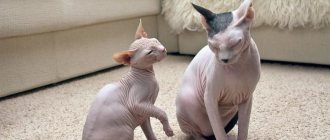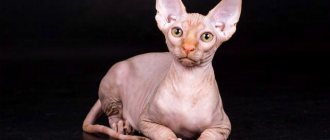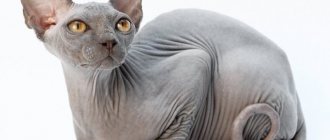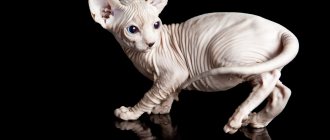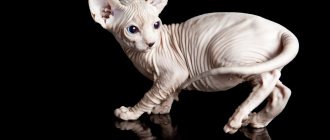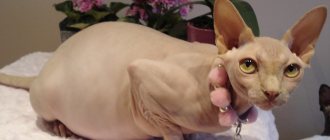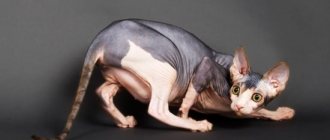The Sphynx cat is a unique breed; despite its somewhat repulsive appearance, these cats have a kind of magic and magnetism. They differ from other breeds in that they lack hair.
It is believed that the Sphynx is one of the oldest cat breeds. During the reign of the ancient Egyptian pharaohs, it was a revered and sacred animal. Hairless Egyptian cats were lost to history, but their species was revived in Canada about 60 years ago.
How the Sphynx breed was developed
Hairless Sphynx cats got their name from the famous mythical guardian of the pyramids because of their appearance. Attracting a whole range of eyes, they have gained incredible popularity among feline fans. But few people know that the breed was first mentioned many years ago in ancient papers. These exotic creatures were sacred.
Today, there are several breeds of Sphynx cats, which create one type of hairless cat. The breed of Canadian cats without fur appeared at the moment when an inconspicuous cat gave birth to a hairless kitten. After numerous studies, it was discovered that a special gene was inherited, which in turn is responsible for the lack of hair.
The Don breed of hairless cats was also discovered by chance. They tried to cure the cat, which was found on the street, for a long time, but it turned out that the pet was completely healthy. Her offspring were also distinguished by their lack of hair from other cats.
After some time, as a result of crossing the Don breed and a shorthair cat, a new line of the genus of all St. Petersburg hairless cats arose.
Origin story
Two hairless breeds are recognized - the Don and Canadian Sphynxes.
The history of the Canadian breed began in 1966, when an ordinary cat in Canada gave birth to a hairless kitten. The baby was given the nickname Prune. He was crossed with his mother, resulting in both furry and hairless cubs. Prune continued to participate in matings with relatives. Hairless kittens were born weak, many died.
The history of the breed could have ended before it really began, but in 1975 a boy was born in the city of Waden, who was given the nickname Epidermis. Then a healthy bald girl was born. These individuals were sent to a nursery for breeding. Thus began the successful spread of the breed.
The history of Don cats is shorter. In 1986, Rostov resident Elena Kovaleva saw boys mocking a kitten. The woman drove away the hooligans and took the unfortunate animal home. The stress experienced was so strong that all the fur came out of the kitten, named Varvara. The treatment was unsuccessful.
Description and general breed standard
The Sphynx cat is naturally endowed with a slender and, not surprisingly, strong and muscular body. The main difference is, of course, the skin, which has no hair or barely noticeable cover.
It is a mistake to assume that all representatives of this breed are bald - the Sphynx with hair is not new for a long time.
What also makes the Sphynx stand out is its large, slightly pointed, erect ears and almond-shaped eyes. The head is diamond-shaped. The nose is straight and flat. In general, such an elegant muzzle is a bit reminiscent of unearthly creatures. The slender, flexible body flows smoothly into long limbs and a straight, thin tail.
The color of the sphinx can be completely different: plain, spotted, two-color, bicolor (when in addition to one main shade there is another color). Also, a cat can simply tan, thereby changing color.
As for the pregnancy of Sphynx cats, it proceeds quite favorably and calmly. During this period, you should not introduce the expectant mother to new foods, but you need to feed her more often. Despite the uniqueness of the breed, a pregnant Sphynx cat needs the same care as all felines during this period. Between two and five kittens are born in a litter.
First mentions
We find the earliest information about cats lacking hair in antiquity, the annals of Egypt and the legends of the ancient Aztecs. There is reason to believe that they are descendants of a extinct breed - the Mexican Hairless, whose representatives finally disappeared in the 19th century. Its characteristic features were:
- long body;
- wedge-shaped head;
- long mustache;
- fur on the back and tail, disappearing in summer;
- amber colored eyes.
There are also known references to the Egyptian sphinx, figurines of which are found in the tombs of the pharaohs. According to legend, they were intermediaries between the world of people and gods, guarding the entrance to the tomb of the pharaohs.
Features of the Sphynx breed (comparative table of species)
| View | Canadian | Donskoy | Petersburg |
| Head | Slightly long head. Straight and flat nose. There is a depression between the nose and forehead. Pronounced cheekbones. The neck is not too long and muscular. | Pronounced brow ridges. There are vertical folds on the flat forehead. There are also folds on the head and neck. The nose is straight and flat. | Diamond shaped head. The forehead is flat. The profile is slightly convex. The neck is thin and long. The cheekbones are flat, not sharply expressed. |
| Ears | Erect and wide. | Slightly tilted forward. Wide, with rounded ends. | Slightly pointed tips. The wide ears are set far apart. |
| Eyes | Wide, almond-shaped, slightly slanting. Color may vary. | Almond-shaped, there is an inversion of the eyelids. The color can be any. | Small, almond-shaped. The color is often bright green or blue, but blue is also possible. |
| Body | Flexible, muscular body of medium size, soft and very warm. The tail is long and straight. | ||
| Weight | 3-5 kg | ||
| Cover | Elastic and thick. To the touch it resembles suede, the length is no more than 2 mm. | Elastic and soft, hot to the touch, folds present. In cold weather, it may become covered with fluff in some areas. | Elastic, has a large number of folds, especially on the head. Hot to the touch. |
| Color | Can be varied. There are both single-color and two-color spotted sphinxes. | ||
Sphynx cat character
At first glance, if you look at a photo of a Sphynx cat, it may seem that the pet is very unfriendly and rude. In fact, Sphynx cats have a character characterized by unimaginable warmth and love for their owner; they are very bored in his absence.
Cats quickly get along with other pets, if any, and show care and friendliness, not even allowing the thought of causing harm. They get along well with children, because they love to be the center of attention. Pets are amenable to swaddling in children's games and will not be angry if a child decides to decorate a cat's body with a design.
Sphynx cats are one of the most peaceful, unforgiving and altruistic breeds. Despite all the significant advantages, if you don’t give your kitten enough attention and affection, the animal can become embittered and aggressive.
Raising a pet
Such cats have developed intelligence; they quickly understand what is required of them. In addition, the character of the Sphinx makes him obedient, attentive, and unforgiving. It is better to prevent negative consequences with cats in advance. Raising such animals is simple, but using punishment is impossible. They do not submit to physical pressure and do not tolerate mental violence well. It is extremely difficult to achieve anything from a cat using such methods. It is necessary to start raising a kitten in early childhood, the earlier the better. But you can start training at a later age.
Care and maintenance of sphinxes
Since the Sphynx kitten is naturally hairless, you must remember and follow the rules for caring for your pet. The Sphynx's skin secretes a certain lubricant, in other words, sweat, in order to maintain its elasticity. The owner needs to remove excess moisture from the skin every day and bathe his pet frequently. Otherwise, the cat will begin to leave brown spots with a very unpleasant odor wherever he decides to lie down, that is, everywhere.
Ears need to be washed regularly. The skin in these areas is quite thin; it should be treated delicately with a special lotion. Since the eyes are not endowed with eyelashes, they must be wiped daily.
The average body temperature of a Sphynx cat is 38-39 degrees. However, owners should not forget that their pet is deprived of fur and during the cold period it is necessary to stock up on warm clothes. Otherwise, your pet may catch a cold. Also, your pet may get burned if it stays near the battery for a long time.
Kittens' teeth and claws should be cleaned with gauze soaked in herbal infusion. For adult cats, it wouldn’t hurt to buy a special brush and suitable toothpaste. For claws, a file is required to properly grind, as well as special scissors that will allow this procedure to be carried out as efficiently and accurately as possible.
Nutrition
In order to help prolong a cat's life, it is necessary to maintain proper nutrition. What to feed a Sphynx cat? It is worth giving preference to a combined diet. There are some foods that are prohibited for sphinxes: onions, potatoes, fatty meats, sweets and fried foods. Otherwise, you can follow the general rules for all cats.
A special feature of this breed is its appetite: the cat loves to indulge in gluttony and after a good portion can continue to ask for a treat. Do not overdo it and monitor the animal’s daily food intake.
Varieties
We have already found out that the Sphynx breed has three main lines. The division of hairless cats does not end there. At first glance, it seems that the animals have no hair; in fact, they are covered with fluff. According to the type of pile, sphinxes are divided into subspecies: flock, velor, brush. There is another type of breed - naked-born, which have absolutely no hair, not even fluff. They are called rubber or plasticine. This subspecies belongs to the Don line. Atypical for Sphynxes is the variety that has full hair, the so-called straight-haired.
Let's look at the types of fur that are typical for Don Sphynxes and Peterbalds.
Hulborn
From the name it becomes clear that kittens are born completely without hair, even without whiskers, eyebrows and contact hairs on their paws. The skin of such animals has many folds and is warm and sticky to the touch. Due to the presence of brown viscous sweat, animals require daily hygiene procedures. Naked babies can be born with their eyes open, just like people. Their parchment skin does not yet have a final color; what color the animal will become as an adult can be determined by the pads of its paws. Sometimes by winter animals become overgrown with sparse fur, but during the warm period it disappears. Large individuals remain hairless throughout the year.
This subspecies is of particular interest to breeders and is highly valued at exhibitions.
Flock
Kittens, with their delicate fluff, look like velvet peaches. It’s very pleasant to touch them, like touching teddy bears. During the first two years after birth, the hairline gradually becomes thinner and disappears, and the hair follicles completely lose their viability .
Velours
Visually, the kittens appear naked, but if you touch them, you can feel the fibers even thicker than those of flock. There are especially long hairs on the muzzle, tail and limbs, but the top of the head remains completely bald. By running your hand against the fur, you can observe how quickly the thick velvety pile takes on its original position.
Velor sphinxes, in turn, are divided into several more types, which determine the density of the pile.
Light velor has insignificant vegetation with a hair length of 2 millimeters. Most of them are on the paws and not at all on the head. Each kitten has its own hardness of coat.
Point - this type of sphinx is endowed with a fairly long pile (up to 4 millimeters), which grows in certain places - on the paws, muzzle and tail. By winter, the points become especially noticeable.
The downy appearance of velor kittens looks very nice due to the fairly long pile, but it is for this reason that they are of little interest to breeders. Cats of this type have beautiful fluffy tails.
Most subspecies of velor sphinxes become completely bald by the time they reach puberty, and only a few of them walk around with fluff on their paws, tail and muzzle.
Brush
The fur of this type of animal is really hard and messy, like the bristles of an old brush. Sometimes there is no hair on the head, neck and paws completely. Breeders are only interested in brushes to continue the population of naked Sphynxes. Unfortunately, two completely bald individuals do not produce viable offspring. Brushes are used as one of the parents for the appearance of hairless sphinxes.
By the age of one and a half years, the hair may disappear in weakly expressed brushes. Animals endowed with dense fur, through which the skin is not even visible, will wear it until the end of their days.
Straight-haired
Sphynx cats have full fur and do not have the baldness gene. The species originated from the selection of Sphynxes with Oriental and Siamese cats. Representatives of this breed repeat the color of the cats participating in the selection; their hair is short and tightly adjacent to the skin in an oriental style.
Health and breed diseases
Today's sphinxes have good immunity. Anyone can get sick, but in order to avoid suffering for the pet and wasting the owner’s nerves, vaccination should be carried out in a timely manner. According to the vaccination calendar, the first one is given at 8 months of age, then at a year and beyond.
The most common diseases of sphinxes are:
- Turning of the eyelids (entropion). It occurs quite often and does not occur in the mildest form. If you notice watery eyes, do not self-medicate and consult a specialist. This disease can lead to vision loss.
- Skin diseases. Due to the lack of fur, this breed is prone to dermatitis and acne.
- Gastrointestinal diseases and obesity. These problems can arise due to improper nutrition or overfeeding of the animal.
- Ear mite. Check your pet's ears periodically and notice if he scratches them excessively.
- Lichen. This disease is a common problem in hairless cats. Monitor the condition of your skin and if any foreign spots appear, consult a doctor.
Tray training
Training a Sphynx to use a litter tray actually begins from the first day. When the kitten is very small, the tray is placed in the place where he lives (sleeps, eats). The filler needs to be natural and small, as the baby may taste it. Small paws may not like large granules, and he may not want to go to the litter box.
You should watch the sphinx. If he gets worried and starts spinning around, it means he is looking for a place to go to the toilet, at which point he is carefully transferred to the tray. Sometimes the baby makes a puddle on the floor. In this case, you need to moisten a little filler in it and put it in the tray. Next time the kitten will find its toilet by smell.
How much does a Sphinx cost and where to buy it?
The cost of a kitten depends on the purity of the breed and the purpose of purchase. The price varies from $100 to $5000. The cost of kittens on the Internet can be $100-150, but it is unlikely that anyone will sell purebred kittens at that price. The opportunity to purchase a purebred family member as a pet will cost $400-800. If the kitten is needed for breeding, then the amount will increase significantly. Moreover, a cat costs more than a female, although in other breeds it is usually the other way around.
You can buy a Sphynx kitten from breeders in a nursery. When purchasing, you need to pay attention to activity, friendliness and appearance. Look at your parents and check your vaccination documents.
Photos of Sphynx cats can be deceiving, because they do not convey the whole picture of the presence of fur and color. Take this fact into account when choosing a kitten on the Internet. Ask the owners to send you a video of the kitten or show it live via communication means.
Hand Taming
If the sphinx has just been brought into the house, it needs time to adapt. These animals are very affectionate, and when the pet gets used to the hands, he himself will beg for affection.
Standard rules have been developed for accustoming a kitten to handling.
- When the kitten eats, it will feel sleepy. This is a good time to carefully pick him up.
- By talking to the kitten in a monotonous, affectionate voice, they achieve its relaxation. At this moment, the baby should be stroked a little behind the ear or on the neck.
- It is not difficult to lure your pet onto your lap with a treat, and when he begins to treat himself, you can lightly stroke him, but do not hold him by force.
- A baby who loves to play can be lured onto his lap with a toy.
Interesting facts about Sphynx cats
- Each Sphynx has a pattern on its nose, just like a person's fingerprints, it is unique.
- Surprisingly, an allergic reaction to Sphynx cats can also be detected. Because dust is carried on the animal's skin.
- Cats love walks in the fresh air and are not afraid of water treatments.
- Photos of the Sphinx are popular. Photographers explain this by saying that this breed is more photogenic and looks more textured in photographs.
- At birth, kittens have drooping ears, which begin to straighten a month later.
- Sphinxes may feel hot to the touch. This is due to the fact that due to the lack of fur, their normal body temperature is 38-39 degrees.
- In ancient Greek, the breed means “strangler.” The reason for this name remains a mystery.
Training
Sphynxes are not difficult to train, they are intellectuals, and they also strive to please their owner. By the age of 8 months, you can begin to teach your cat various tricks. Compliance with commands is reinforced with food. You need to observe what the animal likes. If he likes to run and jump, he can be taught to overcome obstacles on command. A cat that carries all sorts of things in its teeth can be easily trained to use the “fetch” command.
If it is difficult to establish contact with a cat, he shows aggression, he may need castration.
